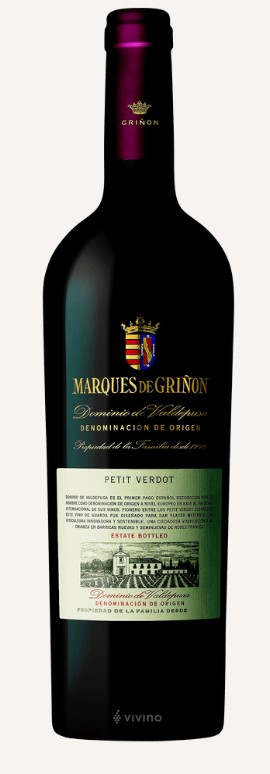Petit Verdot, a dark-skinned grape variety native to Bordeaux, France, may not be as well-known as its counterparts Cabernet Sauvignon and Merlot. However, it is an essential component in many renowned Bordeaux blends, adding complexity and structure to the final wine. In recent years, Petit Verdot has gained recognition as a standalone varietal due to its unique characteristics and ability to produce bold, full-bodied wines with intense flavors and aromas.
In this guide to Petit Verdot, we will delve into the history of this grape variety, exploring its origins in Bordeaux and how it has spread across the globe.
Where Does Petit Verdot Wine Come From?
Petit Verdot, a lesser-known grape variety, originates from the Bordeaux region of France. It is one of the six authorized red grape varieties used in the production of traditional Bordeaux blends. the name Petit Verdot translates to little green in French due to its late ripening nature and small thick-skinned berries. This grape has a long history in Bordeaux dating back several centuries.

While Petit Verdot was once widely planted in Bordeaux, it became less popular over time due to its challenging nature and susceptibility to disease. Today, it is primarily utilized as a blending grape, adding depth and complexity to wines alongside Cabernet Sauvignon, Merlot, Malbec, and Cabernet Franc. However, outside of the classic Bordeaux blend, Petit Verdot has also found success in other regions around the world.
In recent years, Petit Verdot cultivation has expanded beyond France’s borders into different wine regions globally.
Where is Petit Verdot Grown
Petit Verdot, a dark-skinned grape variety originally from Bordeaux, France, has found its way to various corners of the wine world. Spain and Australia are two countries that have embraced this unique grape and have successfully cultivated it in their respective wine regions.

Spain
In Spain, Petit Verdot can predominantly be found in the region of La Mancha, known for its arid climate and high altitude vineyards. The hot summers and cool nights provide optimal conditions for Petit Verdot vines to thrive, resulting in wines with intense color, rich aromas of dark fruits, and firm tannins.
Italy
Over the past few decades, Italian winemakers have been experimenting with different grape varieties. They try to diversify their offerings and create unique expressions of their terroir. While Petit Verdot is not native to Italy, wine makers successfully cultivate it in several regions across the country.

One of the most prominent regions where Petit Verdot is grown in Italy is Tuscany. Known for its world-class Sangiovese-based wines, Tuscan winemakers have embraced Petit Verdot as an excellent blending component. It adds structure and complexity. The warm Mediterranean climate of Tuscany provides ideal conditions for this late-ripening grape variety. It fully develops its rich aromas of dark fruits and violets.
Australia
In Australia, Petit Verdot has gained popularity as a blending grape in the renowned region of Margaret River. This Western Australian region is known for producing exceptional Cabernet Sauvignon-based wines, and Petit Verdot adds depth and structure to these blends.

USA
One of the prominent countries where this grape thrives is the United States. In particular, California has become a renowned region for Petit Verdot production. With its warm climate and diverse terroir, California offers ideal conditions for cultivating this varietal. From Napa Valley to Paso Robles, winemakers are turning to Petit Verdot to add depth and complexity to their blends or even produce single-varietal wines.
Chile
Moving southward across the globe, we find another South American country making waves in the world of Petit Verdot: Chile. Nestled between the Andes Mountains and the Pacific Ocean and central coast, Chile’s unique geography creates a wide range of microclimates that are conducive to viticulture.

Argentina
In Argentina, you can find Petit Verdot predominantly in the renowned Mendoza region. Located at the foothills of the Andes Mountains, Mendoza benefits from high altitude vineyards that provide cool temperatures and ample sunlight. These conditions allow Petit Verdot grapes to develop intense flavors and aromas while maintaining good acidity and structure. In addition to Mendoza, other regions like Salta and San Juan have also embraced this grape variety.
What Does Petit Verdot Taste Like?
Petit Verdot, a lesser-known grape varietal typically used in Bordeaux blends, has gained attention for its bold flavors and unique characteristics. With its dark purple hue and full-bodied nature, Petit Verdot offers an intense sensory experience that is truly unforgettable. On the nose, this wine often presents aromas of dark fruits. Blackberries and plums are accompanied by hints of violets and spices like black pepper or cinnamon.

On the palate, Petit Verdot showcases an array of complex flavors. Its high tannin content gives it a firm structure and a gripping mouthfeel that may even be slightly drying. Notes of black currants, blueberries and sometimes even darker fruits like figs or prunes complement the wine’s robust personality. Additionally, there might be undertones of tobacco or leather that provide added depth to the flavor profile.
Petit Verdot Wine Facts
Petit Verdot, often referred to as the secret grape of Bordeaux, is a lesser-known varietal that adds depth and complexity to many red blends. It typically plays a supporting role in blends from its native region of France. Petit Verdot has gained increasing popularity as a stand-alone wine in recent years. Its intense color, bold tannins, and vibrant flavors are just some of the characteristics that make this grape so unique.

Originating in Bordeaux, France, Petit Verdot has a long history dating back to the 18th century. It was traditionally used in small quantities to add structure and color to Bordeaux blends. However, due to its late ripening nature and susceptibility to poor weather conditions, winemakers often had difficulty achieving full ripeness for this grape.
Petit Verdot as a Blending Grape
Wine lovers are often intrigued by the depth and complexity that a blend can bring to their glass. One grape variety that has gained popularity in recent years for its contribution to wine blends is Petit Verdot. Known for its dark color, intense flavors, and firm tannins, Petit Verdot adds structure and character to various wine styles.

One of the most common applications of Petit Verdot in blends is with Cabernet Sauvignon. The addition of Petit Verdot enhances the overall texture and mouthfeel of the wine. It also adds aromas of black fruits and hints of violet. This combination creates a rich and well-balanced red wine that is perfect for aging. Another popular blend featuring Petit Verdot is with Merlot.
Food Pairing with Petit Verdot
Petit Verdot, often seen as a blending grape in Bordeaux blends, is gradually gaining recognition for its exceptional standalone qualities. With its intense dark fruit flavors, robust tannins, and vibrant acidity, Petit Verdot is a wine that demands attention. And what better way to take petit verdot color elevate your dining experience than by finding the perfect food pairing to complement this powerful red?

For starters, grilled meats are an ideal match for Petit Verdot’s bold characteristics. The wine’s high tannin content and full-bodied nature pair exceptionally well with juicy steaks or lamb chops fresh off the grill.
Five Great Petit Verdot Wines
Il Pino di Biserno 2017 (Italy)
Il Pino di Biserno 2017, the latest addition to the esteemed portfolio of wines from Italy’s Tenuta di Biserno, is causing a stir in the wine community. This impeccably crafted super Tuscan blend showcases the best of what Italy has to offer. With its perfect balance and extraordinary complexity, it encapsulates the essence of Italian winemaking tradition.

Crafted by one of Italy’s most renowned winemakers, Lodovico Antinori. Merlot and Cabernet Franc dominate the Il Pino di Biserno 2017 blend. Small percentages of Petit Verdot and Cabernet Sauvignon are included, too. The result is a wine that exudes elegance and sophistication. On the nose, notes of blackberry, cherry, and plum intertwine with hints of tobacco and spices.
Collazi Ferro 2016 (Italy)
Italy is renowned for its rich tradition and expertise in winemaking. The Collazi Ferro 2016 vintage is a shining example of this legacy. This exceptional wine showcases the unique terroir of the Tuscan region. It offers a sensory journey through its elegant flavors and impeccable craftsmanship.

Crafted with meticulous attention to detail, each bottle of Collazi Ferro 2016 embodies the essence of Italian winemaking. The grapes are carefully handpicked from vineyards nestled amidst rolling hills. Here they benefit from the ideal climate and soil conditions. With a blend primarily composed of Sangiovese grapes, this enchanting red wine captivates palates with its vibrant ruby color and tantalizing aromas of black cherry, plum, and spices.
Cortes de Cima Petit Verdot 2016
Portugal’s Alentejo region is gaining recognition for its exceptional red wines again. The Cortes de Cima Petit Verdot 2016 is a shining example of what this picturesque area has to offer. Made exclusively from the Petit Verdot grape variety, this red wine gem showcases the unique terroir and winemaking expertise of Cortes de Cima winery.

From the first sip, it becomes evident why this wine stands out among its peers. The deep ruby color invites you in, while intense aromas of blackberries, violets, and spices mesmerize the senses. On the palate, its velvety texture coats your mouth with flavors of ripe dark fruits. They complement with well-integrated oak notes that add depth and complexity.
Marques de Grinon Petit Verdot 2019
In the vast world of Spanish wines, one name stands out for its commitment to excellence and innovation: Marques de Grinon. Their latest creation, the Marques de Grinon Petit Verdot 2019, is a true testament to their winemaking prowess. This varietal wine showcases the best qualities of the Petit Verdot grape, offering a unique and captivating drinking experience.

The Marques de Grinon Petit Verdot 2019 boasts a deep ruby color that seduces the eye from the very first pour. On the nose, it reveals an enticing bouquet of dark cherries, blackberries, and violets. The aromas intertwine with hints of vanilla and oak.
Alpasion Grand Petit Verdot 2020
When it comes to exceptional wines, the Alpasion Grand Petit Verdot 2020 stands out from the crowd. This exquisite wine is a true delight for any wine lover. The Alpasion Grand is a remarkable blend of flavors and a rich, velvety texture that will leave you yearning for more. Crafted with meticulous attention to detail by expert winemakers, this vintage exemplifies the finesse and artistry behind each bottle.

The Alpasion Grand Petit Verdot 2020 offers an enticing bouquet of dark berries, cherry compote, and hints of tobacco. This invites your senses on an unforgettable journey. On the palate, it showcases intense flavors of ripe blackberries and black currants. These intermingle with subtle notes of spices and vanilla bean.

